Tree Planting Basics for Minnesota Homeowners
There’s an old saying, “The best time to plant a tree is twenty years ago.” While it makes a humorous point about how long it takes trees to grow, it’s not very practical advice. The other half of the saying is more inspiring: “The second best time to plant a tree is now.” But getting inspired is only the first step. Without some practical tree care knowledge, even well-loved trees can fall victim to incorrect care or accidental neglect.
Some studies estimate the average lifespan of a city tree is only 7 to 13 years. One major cause of this short lifespan is improper planting. Read our expert advice below on how to properly plant your new tree!

Common causes of death in newly planted trees
- Planting too deep—even by a matter of a few inches
- A planting hole that is too narrow for roots to easily spread
- Unhealthy tree stock
- Watering too little or too much—allow soil to dry between waterings
- Environmental factors such as extreme weather, or poor soil
Why is proper tree planting important?
Trees planted today also face stressors trees growing 50 years ago didn’t experience—such as new invasive pests, diseases, changing weather patterns, and increased construction activity. Once you decide to invest the time and energy into adding a new tree to your property, there are several things you can do to give it the best chance to thrive well into the future. A poorly planted tree will be at an increased risk of pests, diseases, and abiotic disorders.
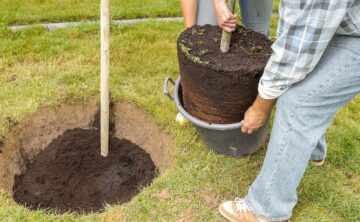
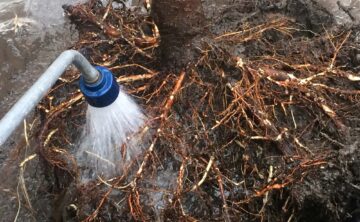
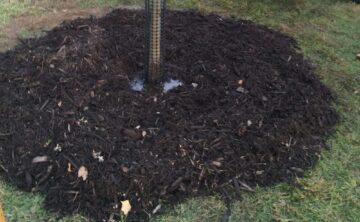
How to plant a tree that will thrive in your yard
1. Do some research to find the best species for your location.
- Consider factors such as the type of tree (shade tree? evergreen? fruit tree?); our hardiness zone; the size it will reach, etc.
- Try the Arbor Day Foundation’s Best Tree Finder: Tree Wizard.
- See our list of Recommended Shade Trees to Plant.
2. Choose the proper placement.
- Allow room for future growth of the tree above and below ground.
- Be sure to factor in structures or other plants in your landscape that it may need to compete with.
- Consider future building, remodeling, or landscaping plans. Tree roots are shallow—digging near the root zone, such as to add plantings or a patio, will harm the tree.
3. Spring and fall are the best times of year to plant a new tree.
- Spring: once the ground has thawed.
- Fall: early in the fall before the ground freezes.
4. Follow proper planting instructions—being sure not to plant too deep!
- Inspect your new tree for girdling roots, or roots that are wrapping around the base of the tree. This often happens as trees are stored in pots or ball and burlap and roots encircle the stem because they lack space to grow outward.
- Remove girdling roots before planting prevents root issues once the tree grows larger.
- Dig a shallow, saucer-shaped hole that is just deep enough to expose the root flare at the ground’s surface. The root flare is the spot where the roots begin to extend sideways from the tree’s trunk.
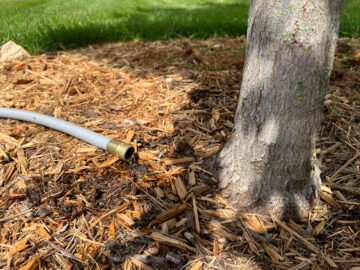
Once your tree is planted, water regularly
- Keep the tree well watered over the next five years. (It typically takes five years for a tree to become established.)
- Water low and slow, with a garden hose placed at the base of the tree keeping the bark dry. Don’t to use sprinklers to water trees as they encourage fungal diseases.
- Plan to water about once a week—more often if the weather is hot and dry; less often if it is wet and cool.
- Read more about proper tree watering from our experts.
Questions about a newly planted tree, or want a consultation on the best place to plant one?
Other items you may be interested in:
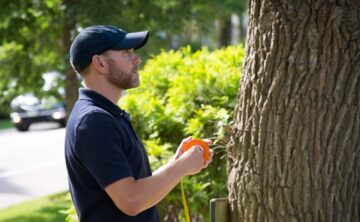
Consulting & Diagnosis
Tree Health Assessment, Consulting, & Diagnosis in Minnesota Are you worried about the health of a tree or shrub in your landscape? Getting it assessed

Finding the Right Ash Tree Replacement in Minnesota
Many people across Minnesota are losing their ash trees because of Emerald Ash Borer (EAB), an invasive species of beetle from Asia. EAB larvae feed on the
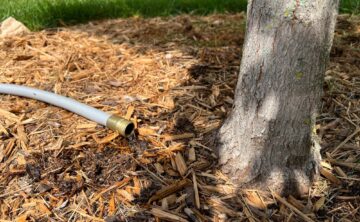
Do I Need to Water My Trees & Shrubs in Minnesota?
The answer depends on the age of the tree or shrub. Newly planted trees and shrubs need regular watering for approximately two years to help



